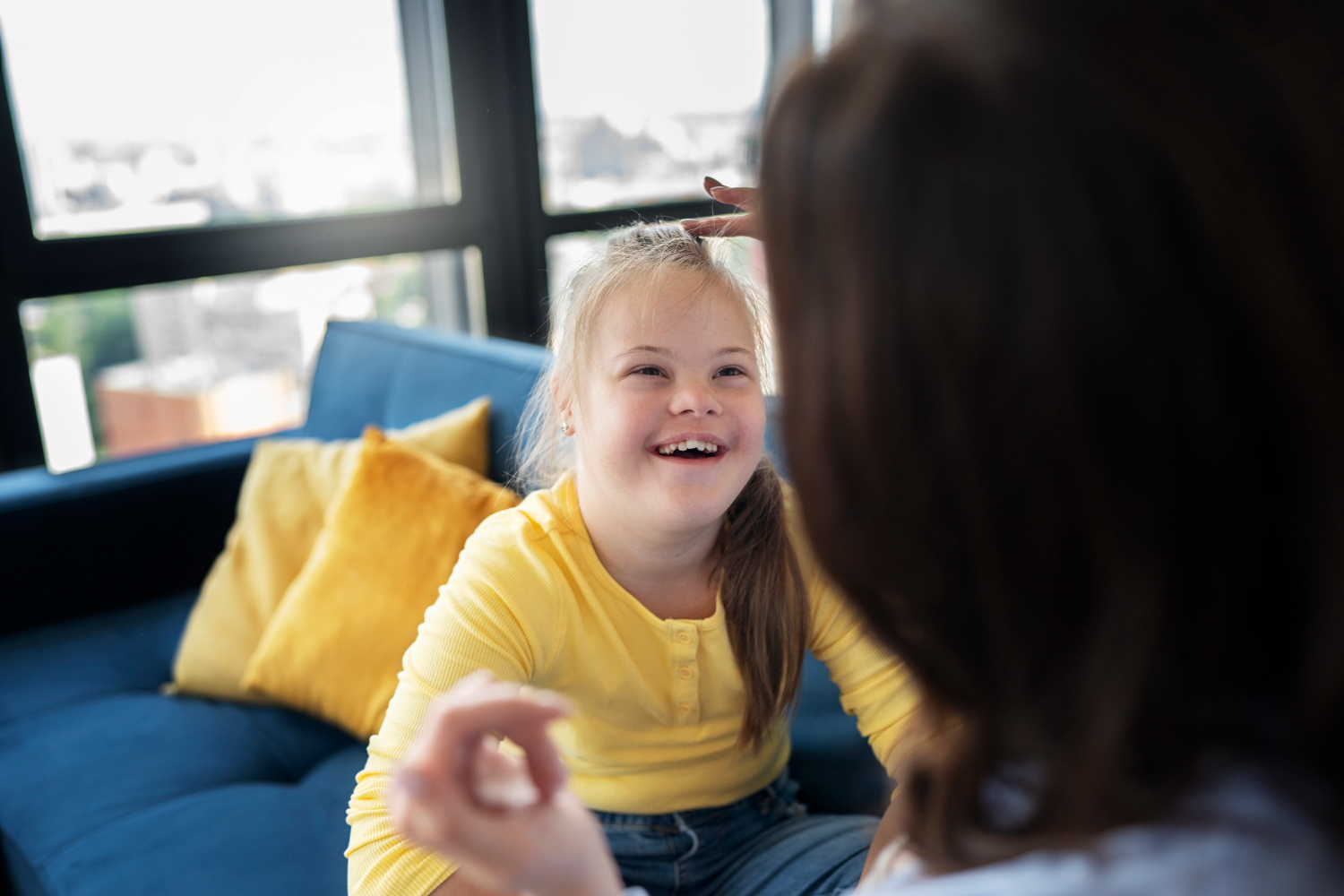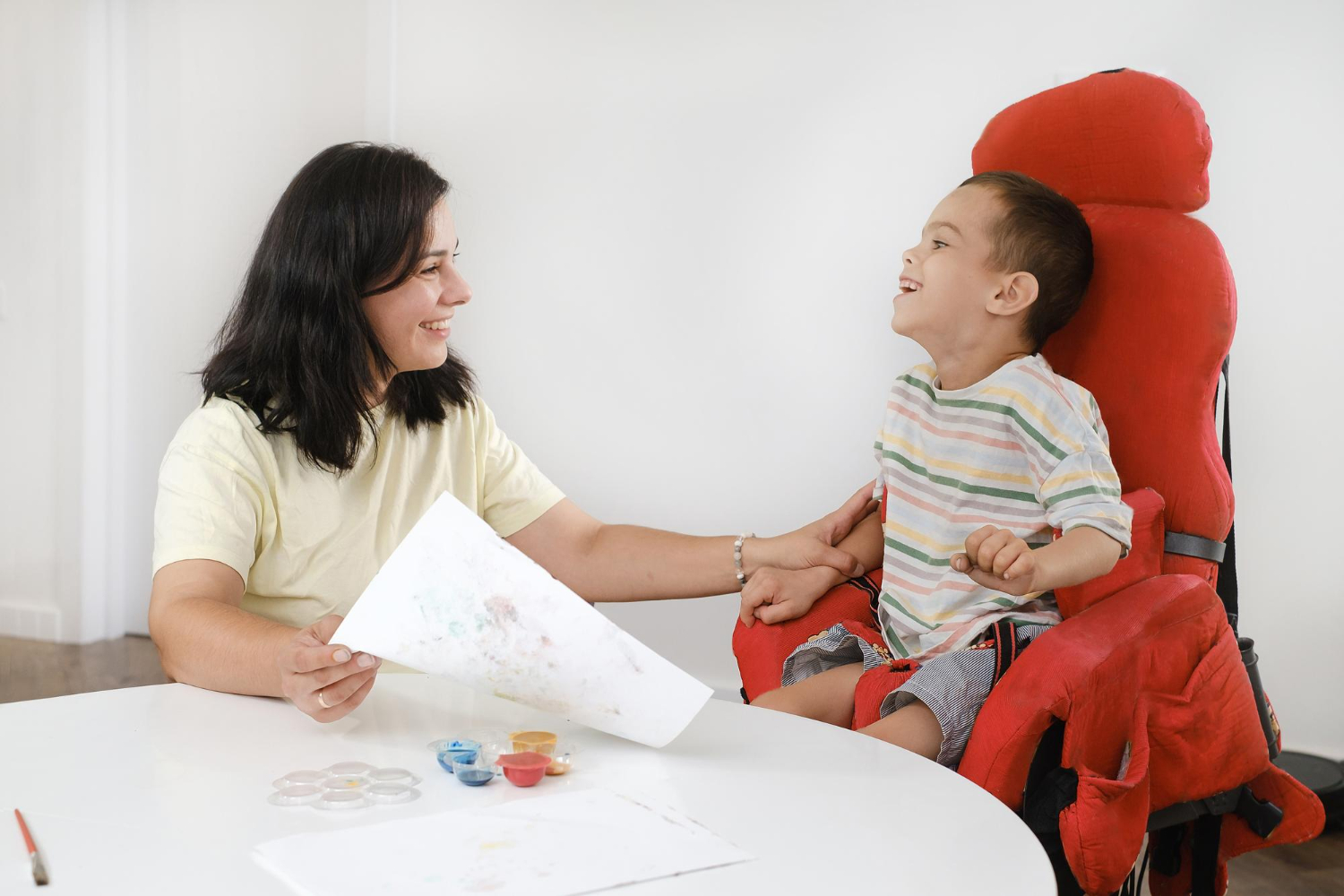Autism, or Autism Spectrum Disorder (ASD), is described as a lifelong developmental condition that affects how a person thinks, communicates, learns, and interacts with the world around them. It is called a spectrum because autism occurs differently in each individual. Some people who belong to that particular category require support, while others may live independently.
Theracare Pediatric Services, believes passionately in helping each child blossom to his or her ultimate potential. Our therapists go through quarterly training to make sure that they are using the latest evidence based research to help your child reach his or her goals.
Signs of Autism Often Show Up Early
Typically occurring before the age of 3, autism is for a lifetime. Lasting throughout life, people suffering with autism may face challenges in:
- Communication and Understanding: People with autism may struggle to communicate, have trouble expressing their thoughts, and have bodily activities that do not align with their facial expressions and gestures.
- Difficulty Learning: Individuals with particular learning patterns may struggle with some basic skills while excelling in music, math, art, or memory-based tasks. Because of this characteristic, they might excel in analysis-based skills and problem-solving.
- Routine Changes: Struggling with their daily life transitions, those who have autism, their daily lives might be troubled because of not being able to adapt to the routine changes.
- Sensory Sensitivities: From bright lights to loud noises, these people react differently to any form and type of sensory input. Having an increased focus on a particular set of activities, with loud noises, certain fabrics, and even food textures, may feel overwhelming, signaling autism. It’s also common for individuals with autism to develop deep interests in specific topics or activities.
Why Are More Kids Being Diagnosed with Autism?

Most children are being diagnosed with autism today, though it does not necessarily mean autism is becoming common. With increased awareness of the conditions and better tools available for diagnosis, more people are receiving aid in the early stages of their diagnosis.
Autism Isn’t Just for Kids
Sometimes, people aren’t diagnosed until adulthood, especially if their symptoms don’t strongly affect daily life in childhood. But no matter when it’s diagnosed, early support makes a big difference in helping people with autism thrive.
Early Help Matters
Children with ASD, if treated early and receiving aid with an early intervention, have improved communication skills, social skills, and independence for children with ASD, setting them up for a brighter future. Working from very early days in their childhood would make their daily functioning easier in adulthood.
Early intervention programs through Theracare Pediatric Services are designed to improve outcomes and promote independence in children with ASD.
Autism Functioning Labels: Why Words Matter
Termed a spectrum, autism occurs differently in different people. No one-size-fits-all method works here. There were harsher terms to describe the capabilities of the person having this condition. Terms like “high-functioning” or “low-functioning” though used could have been misleading and hurtful in certain conditions.
Why High- and Low-Functioning Labels Don’t Work
Though still used in an informal tone, these terms are not included in the official medical language. These oversimplify the wide range of strengths and weaknesses, directly targeting the capabilities and challenges a person with autism may have. For instance, a person who might speak normally may not gel well during social interactions. If they find difficulty in expressing their thoughts, some people might need help with their day-to-day tasks, irrespective of the fact that they are the same people with incredible memories or artistic talents.
At Theracare Pediatric Services, we are a qualified and dedicated team with over 250 Occupational, Physical, and Speech Therapists covering every corner of Arizona. Our goal is to always have a therapy provider available no matter how rural the area.
Understanding Autism Support Levels (DSM-5)
The American Psychiatric Association has created a better, more appropriately fitted word to describe autism in the DSM-5, the official guide for diagnosing mental health conditions. It outlines three Autism Spectrum Disorder (ASD) severity levels based on how much support someone needs:
- Level 1 (Mild) – Needs some support.
- Level 2 (Moderate) – Needs substantial support
- Level 3 (Severe) – Needs very substantial support
These tiers describe how much help a person at a certain level might need internally, no matter how they appear on the outside, in areas such as interpersonal skills and managing communication in their daily lives.
What Do People Mean by “Low-Functioning Autism”?
Statistics suggest that in most people who have autism, around 30% of them have an intellectual disability. This means that they are not mentally able to perform their basic daily tasks and might not live independently. There still are people who refer to this as “low-functioning autism,” which, however, is not an appropriate term to describe a person who might need more substantial support.
What Is “High-Functioning Autism”?
More often than not, some people might show significantly less outward signs of autism. Not having obvious signs of autism, these people can manage their activities in an orderly way, be it at home, school, or work, and typically face fewer challenges with communication. This group altogether is referred to as high-functioning autism or what was once called Asperger’s syndrome. Remember, the term is no longer accepted during diagnosis.
Autism Symptoms to Watch For
In Children:
Symptoms of autism typically appear by age 3. Some children show signs even earlier. Common early signs include:
- Zero eye contact
- Repetitive behaviour(repeating words)
- Strongly inclined to specific topics
- Highly sensitive to touch, smell, sound, etc,
- Difficulty understanding facial expressions, gestures, etc.
- Problems adjusting to changing routines
- Delayed speech or unusual ways of talking (robotic, flat, or sing-song)
Some children may also experience seizures, which can begin during the teen years.
NOTE:
Children may show signs of autism as early as infancy. Look for some additional symptoms, including:
- No response to name by 9 months
- No facial expressions or smiling by 9 months
- No simple games like pat-a-cake by 12 months
- No gestures (waving, pointing) by 12 months
- Doesn’t notice or join group play by 3 years
- Repeats actions like rocking, flapping, or spinning
- Lines up toys in a specific order
- Obsessive interests or behaviors
- Delayed speech or motor development
- Unusual sleep or eating habits
The Bottom Line: Every Autistic Person Is Unique

In all efforts to ascertain that we are making this world a safer and more inclusive place to live in, we should pay full respect and use people-centered language. Discuss support needs, strengths, and individual experiences without focusing on outdated labels. If you’re unsure what terms to use, ask—many people on the spectrum are happy to share how they identify.
Whether you’re seeking a diagnosis or ongoing therapy, Theracare Pediatric Services walks with families every step, with programs grounded in empathy, inclusivity, and evidence-based care.
What Is Stimming?
Termed self-stimulating, stimming refers to self-soothing repetitive movements or actions, from hand or arm flipping to rocking and spinning and making repeated sounds or phrases. People with autism stim to cope with sensory overload and stress or to feel calm and focused. It’s a natural behavior, not something that always needs to be stopped. From using an object over and over again, like flicking a rubber band, touching an object, or twirling a string, people with autism may stim for fun to get rid of the boredom, thus helping themselves better cope with strength and anxiety.
Key Illustrations:
Stimming refers to self-soothing repetitive movements or actions, like:
- Hand flapping
- Rocking or spinning
- Repeating sounds or phrases
- Fixating on objects (twirling, tapping, flicking)
What Are Autism Meltdowns?
Autism meltdowns primarily describe the condition where the person becomes overwhelmed with emotions but is unable to regulate them. Not finding a way to respond to the surge in emotional levels, the person is forced to cry, scream, or lash out lightly. The meltdown should not be considered a tantrum but rather an outburst of emotions, which is regarded as more of a nervous system response. It could also be possible that the person is shut down entirely and finds no appropriate response. You should also help the person by giving them space and enough room to cope with certain outbursts and treat them respectfully, guaranteeing a safe environment.
Autism Types
Doctors once brought these terms into focus, discussing different types of autism and similar developmental disorders. Falling under the range of autism spectrum disorders, these condition existed previously but are no longer discussed:
- Asperger syndrome: Children with Asperger syndrome tend to be between average and above average. Their grading system is based on their performance in intelligence tests. Their scope of interests gets narrowed, considering they have challenges with social skills.
- Autistic disorder: A disorder is the first thought people have in mind when hearing the word autistic. From social interactions to communication and repeated patterns of behavior, this could be anything from a neurological to a developmental disorder; this certainly is a complex developmental condition involving persistent challenges.
- Childhood disintegrative disorder: Childhood disintegrative disorder is a condition in which children develop normally until about age 3. It is a rare and little-researched developmental disorder in which a person experiences normal development for up to 2 years and then loses some or most of their communication and social skills.
- PDD or atypical autism– Pervasive developmental disorder. This term was used more commonly by doctors for children who have some autistic behavior. From delayed social and communication skills, the symptoms here don’t most commonly fit under any other type of autistic disorder.
Autism- Its Causes
Autism, or Autism Spectrum Disorder (ASD), is believed to have been caused by factors including environmental and genetic; it directly affects the brain, disrupting its normal functionality. While no significant evidence could determine the cause, research shows that certain gene variations and mutations—some inherited and others spontaneous—can increase the risk.
Diagnosing Autism
There’s no single test for autism. Diagnosis involves:
- Developmental screening at 9, 18, and 24-30 months
- Comprehensive evaluation by specialists
- Tools like the ADOS (Autism Diagnostic Observation Schedule)
- Input from speech therapists, psychologists, and occupational therapists
You can also request evaluations through your state’s early intervention services.
NOTE:
Vaccines and autism: Vaccines do not cause autism. Even though the speculations around them are a source of autism, studies suggest that no vaccine can cause autism, and there is no link between the two. Vaccines are safe and crucial for preventing serious illnesses.
Testing Autism

A definite diagnosis of autism is not possible. Doctors will still focus on the behavior and the development. Its diagnosis in children usually depends on two basic steps:
Developmental Screening:
- Developmental screening involves a thorough check to tell your doctor if the child is progressing on the right track and coping perfectly with activities, including speaking, learning, and behavior. It ensures doctors observe the children and those developmental delays during their scheduled checkups at 9, 18, and 24 or 30 months.
- If the child shows potential signs of autism during early screenings, a more thorough development is the next crucial step. You do not need a doctor’s referral. You can request an autism assessment through your state’s early intervention program. A team of specialists commands the control during this comprehensive evaluation. This team of elite professionals comprises developmental-behavioral pediatricians, child psychologists, speech-language pathologists, and occupational therapists who will assess your child’s communication skills and behavioral and cognitive development.
NOTE:
Suppose you were not diagnosed with autism during your early childhood days but noticed showing symptoms during later stages. In that case, you should immediately be referred to an autism specialist, an expert who has a detailed understanding of all the symptoms and who will figure out if you have any autism.
What to do after an autism diagnosis?
Receiving an autism diagnosis—whether for yourself or your child—can bring a wave of emotions, and that’s completely normal. Give yourself time to process it, and don’t hesitate to lean on your doctor for clarity and support. Start by learning the basics: explore trusted resources, articles, and expert-approved websites to understand better autism and how it affects daily life. Hearing firsthand experiences from autistic individuals through blogs, books, and videos can also offer powerful insights and comfort. Remember, you’re not alone—support groups, advocacy organizations, and even social media communities can be incredibly helpful. It’s also important to stay mindful of any related health concerns, such as ADHD or dyslexia, and talk to your doctor if new symptoms arise. Autism is part of your story—not the end of it—and with the proper support, you or your child can thrive.
With organizations like Theracare Pediatric Services, we excel in what we do with our therapists who go through quarterly training to make sure that they are using the latest evidence based research to help your child reach his or her goals.
Autism Treatments
Autism is a lifelong condition. Here, intervening early might help. An early detection with a
personalized treatment could make a powerful difference. Especially in the case of a child, if you feel there are chances of autism, be ready to consult a doctor as soon as possible. Since every individual with autism is unique, treatment isn’t one-size-fits-all. Plans are customized based on the person’s needs and often include a mix of the following:
- Behavioral Therapy: Focusing on changing the usual behavior patterns. Identify unwanted behavioral characteristics, determine their causes and effects, and immediately find the solution to the problem.
- Developmental Therapies: Speech therapy for communication is a significant part of developmental therapies. These include physical and occupational therapy for motor skills and everyday tasks like eating and dressing.
- Psychological Support: Cognitive-behavioral therapy (CBT) helps determine the root cause of problems, including stress and anxiety. It also allows people to resist emotional challenges.
- Educational Support: With learning environments explicitly tailored to an individual’s learning needs. There are different teaching styles, each suited to care for the audience.
- Social-Relational Therapies: Focuses on building emotional bonds and improving social interactions.
- Medications: While they don’t cure autism, they can help manage symptoms like hyperactivity, anxiety, or attention issues.
- Complementary Therapies: Creative approaches such as music therapy, art therapy, or animal-assisted activities can help enhance emotional and sensory development.
NOTE:
Applied Behavior Analysis:
One of the most widely recognized treatments, applied behavior analysis (ABA), is logically backed by science and positive behavior. It helps individuals build life skills. ABA may try to suppress behaviors that are part of their identity. Working with a therapist who customizes the approach based on your child’s comfort and goals is essential.
There’s No Such Thing as a “Miracle Cure!”
Despite promises you may hear, there is no cure for autism. Steer clear of unproven or dangerous treatments like:
- Raw camel’s milk
- GcMAF injections
- CEASE therapy
- Chlorine dioxide or MMS
- Secretin hormone
- Chelation therapy
- High-dose or unregulated supplements
Spot a scam by watching for red flags like:
- Claims of instant results or “cures”
- Lack of evidence from reputable health sources
- High costs or personal testimonials without medical backing
- No involvement from licensed medical professionals
Do not try any new therapy unless suggested otherwise. A trusted, evidence-based approach is the best way to support someone with autism toward a healthier, happier life.
Autism and Diet

Diet alone is not the basic treatment of autism. But children, right from the very age when they are on the autism spectrum, how they manage their diet, what they eat, and how they eat plays a crucial role in managing their autism. It is to ensure that no special diets are explicitly made for autism. So, consult your doctor if you plan to change your diet patterns.
However, children with autism indeed have unique eating habits. They might prefer food of a specific color. Eating too little or too much may cause them to chew on non-food items. Some of those with the condition could face digestion-related issues. This could significantly affect their feelings and trigger digestion-related issues during their meals.
Cutting out foods might seem quick, but it can do more harm than good. For example, removing dairy to eliminate casein (a milk protein) hasn’t been shown to improve autism symptoms—and it could reduce important nutrients needed for strong bones.
Supplements
Supplements do not treat or cure autism. Some children on the spectrum may have low levels of essential nutrients like vitamin B6 and magnesium. However, specific vitamins support good health only when consumed within the prescribed limit. Struggling with communication is common for kids on the autism spectrum. Here’s how you can help better interaction:
What Helps:
- Say their name before speaking
- Use short, clear sentences.
- Talk slowly and calmly.
- Use visuals, gestures, and facial expressions.
- Give them extra time to process
Avoid:
- Crowded, noisy environments
- Idioms or unclear language (“hit the road,” “break a leg”)
- Firing too many questions at once
Sleep Tips for Kids with Autism
Sleep issues are prevalent in children with autism. These bedtime tips can help:
Create Calm for Better Sleep:
- Stick to a consistent routine every night.
- Keep a sleep diary to track patterns.
- Use earplugs or white noise if helpful.
- Make their room dark, quiet, and cool
- Talk to a doctor if sleep issues persist
Encouraging Social Skills Without Pressure
Socializing can be overwhelming for children with autism, but you can support them gently:
Try This:
- Ask their school about support programs
- Connect with your autism care team.
- Explore local autism-friendly social groups.
- Learn from other parents and their experiences.
Avoid This:
- Forcing your child into social situations
- Rushing or pressuring them to “make friends fast.”
Theracare Pediatric Services offers one-on-one support to help children build confidence at their own pace.
Conclusion

Supporting a child with autism in his journey requires everything from patience to flexibility and a personalized approach. Every child with autism is unique, and it’s just time to find the right supplements. Try giving them enough time, dedicatedly serving them, and staying committed so they build better cognitive abilities and communication skills, focus on improved sleep routines, and encourage social interaction. Remember, there should not be a one-size-fits-all approach. We understand every child’s unique needs and work closely with healthcare professionals and support networks.
At Theracare Pediatric Services, we understand how important it is to support your child’s growth and independence. That’s why we offer a range of pediatric services—including occupational therapy, speech therapy, physical therapy, and learning support—designed to meet the unique needs of every child.





